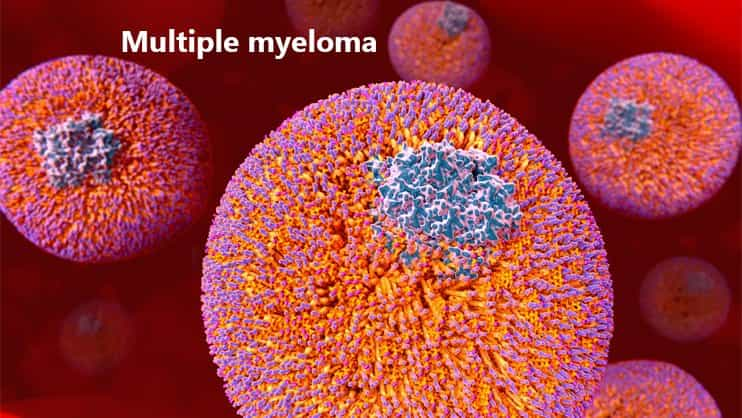Normally, multiple myeloma comes incidentally diagnosed by your doctor by examining routine blood tests, often checking for some other unwell condition. In other situations, it can be directly intercepted if the doctor has a clear suspicion that he is facing symptoms of multiple myeloma.
Diagnosis
The early diagnosis of multiple myeloma is not easy, as multiple myeloma often causes no symptoms until it reaches an advanced stage. It can cause rather vague symptoms, easily identifiable with other diseases. On the other hand, when a routine blood test reveals an abnormally high amount of protein in the blood, multiple myeloma can be detected early. In the case of people with MGUS (monoclonal gammopathy of unknown significance) or solitary plasmacytoma, there is a risk of developing multiple myeloma, regular blood tests are recommended to monitor its occurrence.
In summary, what are the tests used for the diagnosis of multiple myeloma?
Blood tests: laboratory tests reveal the presence of M proteins, produced by myeloma cells, as well as the detection of the abnormal protein “beta-2-microglobulin” can be useful for the doctor to understand the level of aggressiveness of the myeloma . Additional useful information from blood tests comes from examining kidney function, blood cell counts, calcium and uric acid levels.
Urine test: It shows M (Bence Jones) proteins when detected in the urine.
Bone marrow examination: through bone marrow sampling, carried out with a long needle inserted into a bone (bone marrow aspiration and biopsy), the sample is examined with specialized tests to identify gene mutations.
Imaging Tests: These are tests recommended for detecting bone problems related to multiple myeloma: an X-ray, MRI, CT or positron emission tomography (PET) scan.
Treatments
Targeted therapy: can be used in those cases where pharmacological treatments must focus on specific weak points within the cancer cells. By acting against these anomalies, only the diseased cells can be killed.
Immunotherapy: it uses the immune system itself to fight cancer, although the immune system may not attack cancer cells. They have the ability to produce proteins that help them hide from the cells of the immune system.
Chemotherapy: Using drugs to kill cancer cells target fast-growing cells, including myeloma cells. Before a bone marrow transplant, high dosages of chemotherapy drugs are used.
Corticosteroids: they regulate the immune system for and are also active against myeloma cells.
Bone marrow transplant: Stem cell transplant is a method of replacing diseased marrow with healthy bone marrow. As mentioned, prior to a bone marrow transplant, high doses of drugs will be used to destroy the diseased marrow; then, your stem cells will be infused into your body, where they will go to rebuild the bone marrow.
You may also like
Hearing loss: things to know before buying a hearing aid
Choosing a hearing aid isn’t easy, especially if you’ve never used one. They come in different shapes, colors and levels of technology.The first factor in determining which hearing aid to choose is your hearing loss, which could range from very mild to severe. Next, you need to know what you would like it to be… Continue reading Hearing loss: things to know before buying a hearing aid
Small Lymphocytic Lymphoma (SLL): Symptoms and Treatments, Causes and Diagnosis
Small lymphocytic lymphoma (SLL) is a cancer of the immune system. It affects infection-fighting white blood cells called B cells. SLL is a type of non-Hodgkin’s lymphoma, which along with chronic lymphocytic leukemia (CLL) indicates the same type of disease, treated the same way. Whereas in SLL, the cancer cells reside primarily in the lymph… Continue reading Small Lymphocytic Lymphoma (SLL): Symptoms and Treatments, Causes and Diagnosis
Diabetes Type 2: Epidemiology and Prevention
Diabetes Epidemiology Diabetes is a very common disease. New updated data from the new International Diabetes Federation (IDF) Diabetes Atlas show that more than 34 million Americans have diabetes (1 in 10 individuals), of whom approximately 90-95% have type 2 diabetes. In UK the situation is slightly better: with nearly 4 million sufferers, about one… Continue reading Diabetes Type 2: Epidemiology and Prevention
Small Lymphocytic Lymphoma (SLL): Stats, Causes and Diagnosis
Small lymphocytic lymphoma (SLL) is a cancer of the immune system that affects the white blood cells that fight infection, called B cells. SLL is a type of non-Hodgkin’s lymphoma, as is chronic lymphocytic leukemia (CLL). Both cancers are basically the same disease, and are treated in almost the same way. The difference between the… Continue reading Small Lymphocytic Lymphoma (SLL): Stats, Causes and Diagnosis
